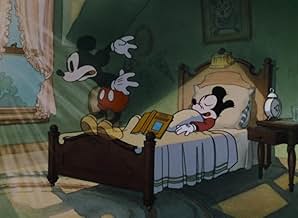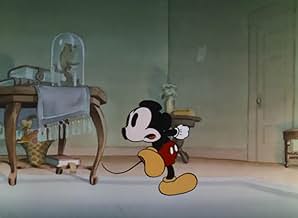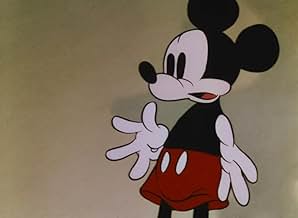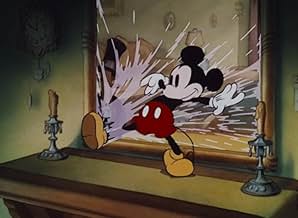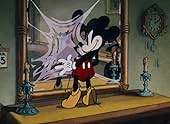Agrega una trama en tu idiomaMickey has been reading Lewis Carroll's "Through the Looking-Glass, and What Alice Found There", and falls asleep. He finds himself on the other side of the mirror, where the furniture is al... Leer todoMickey has been reading Lewis Carroll's "Through the Looking-Glass, and What Alice Found There", and falls asleep. He finds himself on the other side of the mirror, where the furniture is alive. He eats a walnut, which makes him briefly larger, then small. He dances around a lot,... Leer todoMickey has been reading Lewis Carroll's "Through the Looking-Glass, and What Alice Found There", and falls asleep. He finds himself on the other side of the mirror, where the furniture is alive. He eats a walnut, which makes him briefly larger, then small. He dances around a lot, ultimately doing a major number with a deck of cards. He dances with the queen, making th... Leer todo
- Dirección
- Guionistas
- Elenco
- Mickey Mouse
- (voz)
- (sin créditos)
Opiniones destacadas
Like the famous literary Alice, Mickey goes THRU THE MIRROR to find himself in a very strange room where almost anything can happen...and probably will.
Here is one of the classic Mouse films - an exercise in sheer exuberant delight. Taking Lewis Carroll as the departure point, the Disney artists crafted a tale of visual excitement & great good fun. Music propels the action and Mickey's joyous dance - backed up by matches, white gloves & a whole pack of cards - proves to be a salute to both Fred Astaire & Busby Berkeley. The Queen of Hearts card - the Mouse's soulful dancing partner at one point - is a spoof of Greta Garbo. Look fast near the end for a quick cameo by King Neptune, who starred in his own SILLY SYMPHONY back in 1932. Walt Disney provides Mickey with his squeaky voice.
Walt Disney (1901-1966) was always intrigued by drawings. As a lad in Marceline, Missouri, he sketched farm animals on scraps of paper; later, as an ambulance driver in France during the First World War, he drew figures on the sides of his vehicle. Back in Kansas City, along with artist Ub Iwerks, Walt developed a primitive animation studio that provided animated commercials and tiny cartoons for the local movie theaters. Always the innovator, his ALICE IN CARTOONLAND series broke ground in placing a live figure in a cartoon universe. Business reversals sent Disney & Iwerks to Hollywood in 1923, where Walt's older brother Roy became his lifelong business manager & counselor. When a mildly successful series with Oswald The Lucky Rabbit was snatched away by the distributor, the character of Mickey Mouse sprung into Walt's imagination, ensuring Disney's immortality. The happy arrival of sound technology made Mickey's screen debut, STEAMBOAT WILLIE (1928), a tremendous audience success with its use of synchronized music. The SILLY SYMPHONIES soon appeared, and Walt's growing crew of marvelously talented animators were quickly conquering new territory with full color, illusions of depth and radical advancements in personality development, an arena in which Walt's genius was unbeatable. Mickey's feisty, naughty behavior had captured millions of fans, but he was soon to be joined by other animated companions: temperamental Donald Duck, intellectually-challenged Goofy and energetic Pluto. All this was in preparation for Walt's grandest dream - feature length animated films. Against a blizzard of doomsayers, Walt persevered and over the next decades delighted children of all ages with the adventures of Snow White, Pinocchio, Dumbo, Bambi & Peter Pan. Walt never forgot that his fortunes were all started by a mouse, or that simplicity of message and lots of hard work will always pay off.
And of course there's everything with the cards, which at first are like dancers from a Busby Berkley musical (I'm sure the animators had influences from those movies, in full formation they do it up), and then the way that Disney and his writers bring in the Queen of Hearts and the King (the latter on both bottom and top levels with swords). It's also wonderful to see all the cards chasing after Mickey; I have to wonder if the animators (or just Disney himself) knew the potential to have mass figures overpowering the flagship character, and brought it over when doing something like Fantasia, as the cards have that unstoppable-holy-crap quality of the ravenous brooms.
The imagination here is boundless, and when there are gags (the chair and its baby, the umbrella, the radio that shouts out "Calling All Cards") they work well, but ever since I saw this as a kid - and through some repeat, partly from the first Mickey Mouse VHS and play from back when the Disney channel actually played these old-time cartoons I've seen it many times - I knew it had a special quality. The pacing is electrifying, the comic timing excellent, and the music combines Big-Band Jazz, musical and adventure/chase music. In a way this is one of the great Alice adaptations, distilled to just a few points like a song, and the notes played by some smart people. Did I mention in that bright, excellent early cartoon-Technicolor to boot?
¿Sabías que…?
- TriviaThis short is featured as a playable level in the video game Epic Mickey (2010).
- ErroresThere is a series of scratches visible throughout, apparently from the platten glass used to hold the artwork under the camera.
- Citas
King of Hearts: [top half] Call out the cards!
King of Hearts: [bottom half] Call out the cards!
King of Hearts: [both halves] Call out the cards! Call out the cards!
Radio: [repeatedly] Calling all cards. Calling all cards.
- ConexionesEdited into El Mundo Maravilloso de Mickey (1968)
Selecciones populares
Detalles
- Tiempo de ejecución9 minutos
- Relación de aspecto
- 1.37 : 1
Contribuir a esta página



